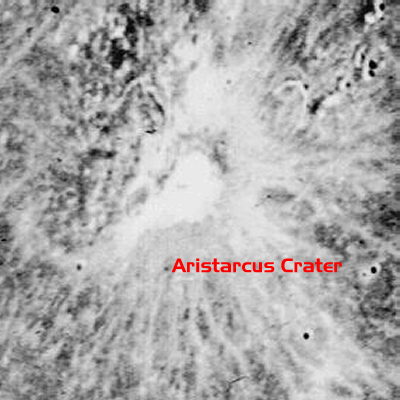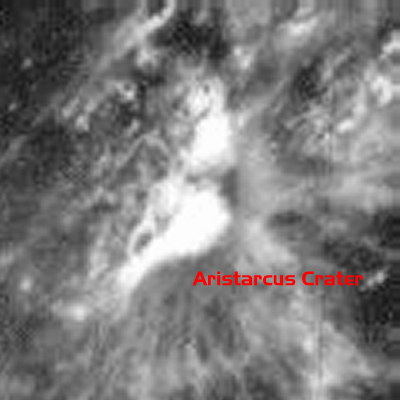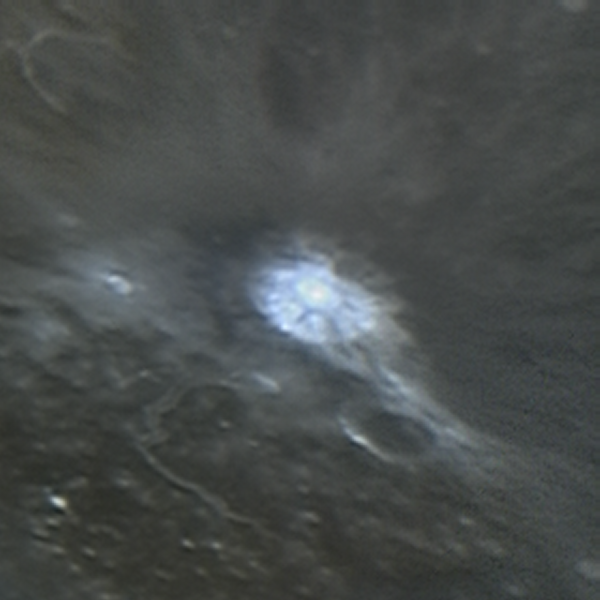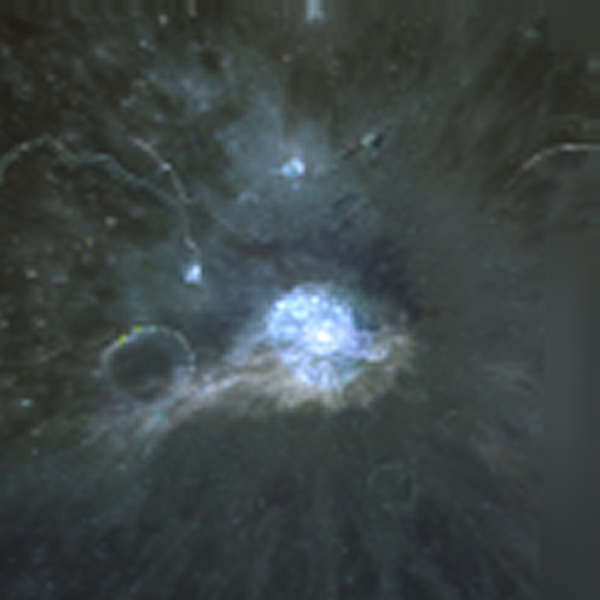|
|||||||||||||
|
Electric Blue Gem or Fusion Reactor? .
Aristarchus Crater has long been a much debated enigma
on the Moon. Yet whenever you see pictures and try to get close in for
details, the area is a total white out, with no detail. It is supposedly
because of its brightness. We will discuss the rumors and stories of Aristarchus
further down. The image above is taken from LICKOSB9 As you can see the
area is devoid of any gray pixels, leaving a totally white splotch. Below
is the same area on LICKOSBA. Again we see the totally white splotch. You
will find this in all of the lesser quality full moon images on the web.
|
|||||||||||||
|
. Aristarchus Crater Dec 17th 2005 .
If you haven't already seen the Full Moon that Mike took where this clip of Aristarchus is a small section, you can do so HERE. The picture above is Aristarchus Crater clipped from an image taken with a 10" Telescope in the UK. Compare this image to the high resolution image from the Clementine Satellite below and remember that this is a 10" telescope image. You will notice the symmetrical dome like structure of the "crater" as well as the bright blue glow that literally lights up the surrounding area! The overall effect is that of plasma energy emitting from the dome, or at least very bright light. Electric Blue Crater
The image above is cropped from the full spread Clementine Nearside.tif image. Click on the image to see one cropped from the 65 meg version. Both the Clementine and Mike's image show the beautiful "Electric Blue" color of the crater and both show dome like structures, with a bright center. Both also show that the luminescence covers the surrounding area. Now we have a third confirmation... this one is also from the UK UPDATE
The images above are clips from
the US NAVY original Clementine gallery, Clementine
Lunar Image Browser 1.5. The data set was only available in low resolution,
heavy pixelated jpg images but even in those you can see the "glowing structure"
and the rectangular area that is clearer than the surrounding area
|
|||||||||||||
|
Aristarchus Crater
The same pretty Blue Gem we see from Clementine! The same glow emanating from the center flooding the area. The image above is from another well known British astronomer, Anthony Jennings, using an 8" LX90 SCT telescope and a Philips ToUcam 2xBarlow camera. The image below is an enlarged clip. Anthony has no connection to Pegasus and his images are freely available at his web site; Anthony Jennings Astronomy Site Both these Astronomers captured the "Blue Gem" on the same day from two locations, Date: 17th December, 2005. This is a clip from a Moon Mosaic of 120 images (Mike used 170). This time the scope is even smaller... an 8 inch scope! Image Notes:
Important Note: Neither Mike Deegan nor Anthony Jenkins are part of Pegasus or the Living Moon and are merely Astronomers that have taken excellent images. As such they do not necessarily share our views about Aristarchus, nor follow our research |
|||||||||||||
|
Aristarchus Crater
Though not as high a resolution, we can still see the blue glow in these three images. John Lear believes this to be a Fusion Reactor. Other
members of Pegasus have different ideas, but all are related to some sort
of power device. We now have several images from several independent sources
showing the electric blue glow and the "structure". All the images we have
seen where "the lights are on" show this regular uniform structure, yet
many photos can be found that show just a crater.
|
|||||||||||||
|
From this and other documentary evidence we have gathered, it appears that this phenomena is not always on. When all the data is correlated it will be presented here on this website. but here are a few observances around Aristarchus Crater... Report Nov 2-3, 1958 "On the night of November 2-3, 1958, Russian astronomer Nikolai A. Kozyrev witnessed a strange phenomenon while making spectrograms of the crater Alphonsus with the Crimean Astrophysical Observatory's 50-inch reflector. As he watched through the telescope's guiding eyepiece, he saw the crater's central peak blur and turn an unusual reddish color. The spectrograms confirmed his visual impressions of a volcanic event; they showed an emission spectrum of carbon vapor (S&T:February, 1959, page 184).. Kozyrev has recorded via spectrograms numerous incidents of red transient lunar phenomena, particularly in the 80 mile wide crater known as Alphonsus. It was at this location in 1965 that the final Ranger probe 9 crash landed. Aristarchus is not only one of the brightest formations on the moon, it is responsible for more than half the number of reported TLP and has been a proven source for gaseous emissions - Farshores.org Reports 1650 to 1950 NASA Technical Report TR R-277. was published in July 1968 as a Chronological Catalog of Reported Lunar Events and is available here - NASA Technical Report TR R-277 1650 Aristarchus "Red Hill." Mons Porphyrites Hevelius B.A.A. Lunar Sec. Circa. 1967, 2, No 8 1784 Aristarchus
Nebulous bright spot of light Schroter Schroter 1791
1824 May 1 Near Aristarchus
Blinking light, 9th to 10th mag.. on dark side Gobel Gobel
1826
1931 Aristarchus
Bluish glare Goodacre, Molesworth Goodacre 1931
1950 Jun 27, 02h30m Aristarchus
Blue glare, base inner W wall Bartlett Bartlett 1967
Author(s): Cameron, W. S.
NASA Lunar transient phenomena catalog
Report April 23, 1994 Sky and Telescope published an article basically saying anyone who sees a TLP is just seeing an illusion, despite hundreds of sightings by reputable astronomers... Well April 23, 1994 would change that dramatically... and involves our friend Clementine "A satisfying rebuke to the
TLP naysayers was recently delivered by JPL's B. Buratti at the October
1999 meeting of the American Astronomical Society in Padua, Italy. Her
specific TLP occurred on April 23, 1994. At that time, about one hundred
amateur astronomers noticed a 40-minute darkening near the edge of the
bright lunar crater Aristarchus. Happily, when this hundred fold "illusion"
took place, the lunar satellite Clementine was mapping the area around
Aristarchus. Defying the dogmatists, Buratti scrutinized the Clementine
data again. Sure enough, Aristarchus had really turned redder after the
TLP reported by the amateur astronomers."
Report July 19, 1969 Apollo 11 provides us with this incidence that gives a perspective of one event from two angles... one on Earth and one in orbit around the moon. "On July 19, 1969,
the Apollo 11 command module had just achieved orbit
around the Moon when the Mission Control Center in Houston, Texas,
received word that amateur astronomers reported transient phenomena
in the vicinity of the crater Aristarchus. Asked to check out
the situation, astronaut Neil Armstrong looked out his window toward
the earth lit region and observed an "area that is considerably more
illuminated than the surrounding area.
|
|||||||||||||
|
REPORTS of curious flashes and fleeting clouds on the Moon may not be figments of wild imaginations, astronomers say. A new look at observations by the American satellite Clementine show that a small area on the Moon's surface darkened and reddened in April 1994. Why this happened remains a mystery. For hundreds of years, people have reported seeing flashes, short-lived clouds and other brief changes on the Moon's surface. But astronomers have never been able to confirm the sightings. "The events were observed on many occasions, but most astronomers don't believe in them," says Bonnie Buratti of NASA's Jet Propulsion Laboratory in Pasadena, California. On 23 April 1994, around a hundred amateur astronomers reported seeing a possible darkening of the Moon, lasting 40 minutes, near the edge of the bright lunar crater Aristarchus. At the same time, the US Department of Defense's Clementine satellite was mapping the lunar surface.
One of the first real attempts to catalogue a large number of TLP sightings was made on behalf of NASA and published in a report which gave details of 579 mysterious lunar events dating from 26 November 1540 (pre-telescopic) to 19 October 1967 [4]. The catalogue appeared just a year before Neil Armstrong planted his size 11 boot in the Sea of Tranquillity; strange that such an important and well-funded Moon-landing programme chose to arm itself with some basic historical TLP data only at the very last minute. NASA's belated enquiries represented a grudging acknowledgement that the Moon might not actually be the dead world it so convincingly advertises itself to be for most of the time. It was in NASA's interest, however, to down-play the idea of an active Moon. Known factors in lunar exploration were hazardous enough to plan for and contend with, without having to admit that lurking somewhere beneath the Moon's surface there might be some unknown, unpredictable and uncontrollable threat to their prospective Apollo lunar astronauts which could jeopardize the $25 billion programme. SOURCE: Fortean Times FT105 December 1997"Light Side of the Moon" |
|||||||||||||
|
Apollo 11 Transcript from Mission Log .
This page is a copy of the Mission Debriefing Log after they came back to Earth. John Lear has a copy of this in his collection. What I find interesting is the other area that was "lit up" and was not Aristarchus. Aldrin says they could look in the films, but we all know what happened to those films... |
|||||||||||||
Excerpt 001
Excerpt 002
Excerpt 003
Excerpt 004
Excerpt 005
Excerpt 006
Excerpt 007
Excerpt 008
Summary.... So it is established that Aristarchus has an unusual glow and that it is in the blue, violet and ultra-violet range. Here we also have brief mention (citing other papers which we are looking for) of a Lunar atmosphere in a NASA/JPL paper, and furthermore they state the night sky on the Moon is illuminated. The table above shows us that Aristarchus increases in intensity at different times, with a major peak on Oct 2 1955 observed with a 50 inch Russian scope... Below we will give you an idea what the H and K spectrums
represent....
|
|||||||||||||
|
.
The photo above is the spectrum of a glass tube filled with hydrogen that is excited with a high voltage. It resembles a neon sign, except the glass is straight and filled with hydrogen gas and not neon. The important features are the bright emission lines in the Hydrogen spectrum. There is one line in the visible red, the brightness one in the blue, the second from the right is in the violet range and the last in the ultra violet range, not visible to the human eye, but barely detectable with a digital camera. (Data collected from the Warren Wilson College Physics Department) What is relevant in our look at Aristarchus is the intense emission in the blue to ultra violet end of the spectrum of Hydrogen plasma emissions. In the Russian/NASA document we see recorded evidence of strong and variable emissions in this H spectrum as well as the K. In the papers below we can see that the K spectrum emissions also are involved with ionized plasma... "The explanation of the hydrogen spectrum is perhaps the most important test that any theory of electronic structure must pass. The wavelengths of the lines of the Balmer series (shown above) as well as other series in the spectrum of hydrogen are very well known indeed." - University of Kentucky Seems Aristarchus Crater passes that test for "electronic structure" with flying colors |
|||||||||||||
|
Papers: High Resolution Measurement of the K Spectrum of Fe
This paper is organized as follows. In § 2, we describe the EBIT and review our experimental procedure. In § 3, we present our measured spectra and compare them to published predicted spectra for ionizing plasmas. In § 4, we discuss the effects of K-shell ionization and the consequent spectral dependence on the shape of the electron distribution. Livermore Electron Beam Ion Trap (EBIT). The electron density in the EBIT is similar to the electron density of solar flares... All the papers we find dealing with the K Spectrum are all heavy reading in Physics, but they talk about electron emissions, solar and cosmic radiation and Ionized Plasma. Combining these pieces shows us that Aristarchus definitely has emissions in both these spectra, and that the emissions are not always there, and that they have ben recorded at different intensities. Does this make Aristarchus a
Fusion Reactor? We don't know, but the evidence certainly indicates something
along those lines is going on. Time to start looking at the Moon with ultraviolet
cameras...
One last piece of the puzzle... below is a Fusion Reactor that has proven successful at Sandia National Laboratory "Z causes reactions to occur neither by confining low density plasmas in dimensionally huge magnetic fields, as do tokomaks, nor by focusing intense laser beams on or around a target, as in laser fusion, but simply through the application of huge pulses of electricity applied with very sophisticated timing. The pulse creates an intense magnetic field that crushes tungsten wires into a foam cylinder to produce X-rays. The X-ray energy, striking the surface of the target capsule embedded in the cylinder, produces a shock wave that compresses the deuterium within the capsule, fusing enough deuterium to produce neutrons." Sandia National Labs What is most interesting is the
appearance and color of the reactor... This makes it quite conceivable
that when the Aristarchus Reactor is off, you might not see anything unusual
at all. Perhaps a closer look at those pictures that show it close up might
show something inside
|
|||||||||||||
|
Z MACHINE
|
|||||||||||||
|
The Levitated Dipole Fusion Confinement Concept .
Welcome to the Levitated Dipole eXperiment (LDX) web site. LDX is a novel experimental device designed to explore the physics of plasma confinement in a magnetic dipole field. What makes it unique? Besides levitating a 1/2 ton super conducting ring, we will conduct the first experimental test on the theory of plasma confinement by adiabatic compressibility. If this concept turns out to be correct, levitated dipoles may one day make an attractive magnetically confined fusion energy source. LDX is a collaboration between Columbia University's Dept. of Applied Physics and the MIT Plasma Science & Fusion Center and is funded by the Department of Energy's Office of Fusion Energy. A levitated dipole would be favorable for a D-He3 fuel cycle based power source. Additionally a levitated dipole device would be intrinsically steady state and extract power as surface heating, permitting a thin walled vacuum vessel and eliminating the need for a massive neutron shield. |
|||||||||||||
|
High resolution measurement, line identification, and
spectral modeling of the Kb spectrum
K-shell x-ray spectra involving transitions from levels
higher than n52 have been studied in much less detail. We
Our measurements include the positions and strengths
of the 1s2l3l8-1s22l and 1s2l4l8-1s22l lithium like satellite
tokamaks - A tokamak is a machine producing a toroidal (doughnut shaped) magnetic field for confining a plasma. It is one of several types of magnetic confinement devices and the leading candidate for producing fusion energy. The term Tokamak is a transliteration of the Russian word ??????? which itself comes from the Russian words: "???????????? ?????? ? ????????? ????????" (toroidal'nayakamera v magnitnykhkatushkakh |





























